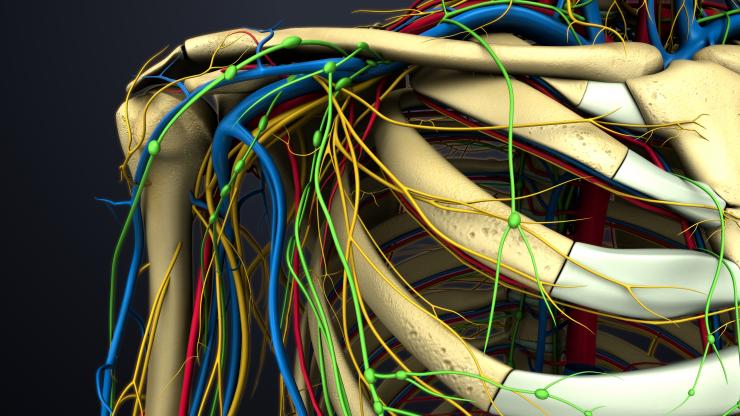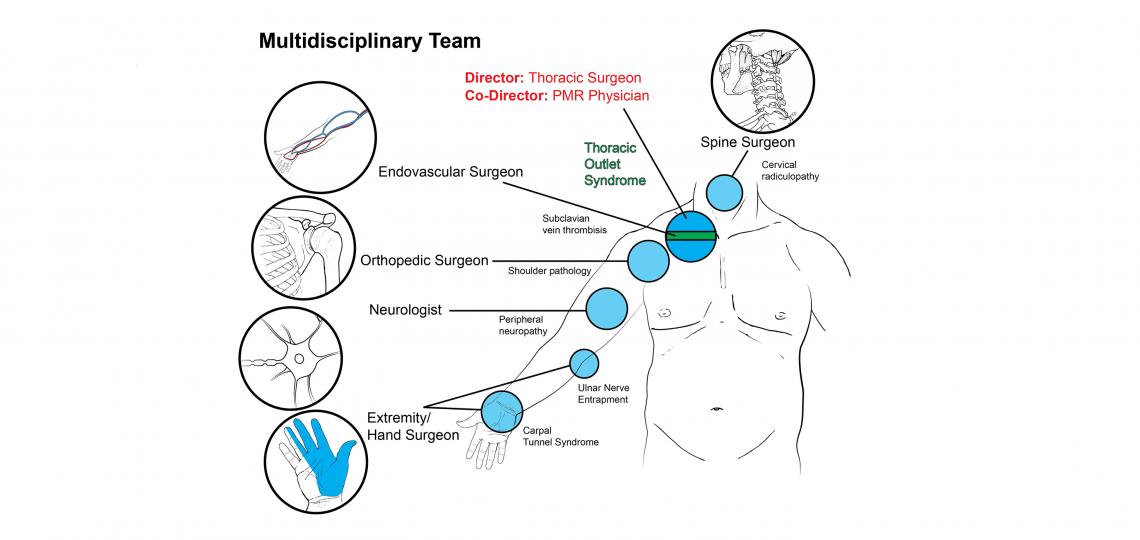The Thoracic Outlet Clinic at Baylor Medicine in Houston, Texas, is a multidisciplinary clinic that specializes in the care of patients with thoracic outlet syndrome (TOS). Our clinic is led by specialists experienced in the diagnosis, surgical and nonsurgical management of neurogenic and vascular thoracic outlet syndromes.
We offer a comprehensive diagnostic and treatment program tailored to the individual needs of patients suffering from TOS and related diseases.
Our team incorporates experts in the fields of thoracic surgery, vascular surgery, physical medicine and rehabilitation, pain management, neurology and spine - all committed to streamlining the management of this condition.
What You Should Know About TOS

There are three types of Thoracic Outlet Syndrom: Neurogenic, Venous and Arterial.
Neurogenic TOS
Ninety-five percent of cases of TOS are due to compression of the nerves to the arm (called neurogenic TOS). Neurogenic TOS is most often the result of neck trauma such as a whiplash injury. Slipping and falling on floors or ice, or repetitive stress from working on assembly lines or keyboards are the next most common causes. The symptoms are due to scar tissue formation in neck muscles (called scalene muscles).
In neurogenic TOS, the symptoms are pain, numbness, tingling, and/or weakness in the arm and hand. Also common is a tired feeling in your arm, which is made worse by working with your arms raised over your head. Neck pain and headaches in the back of your head are also frequent symptoms. Another common occurrence is pain that starts in your shoulder and runs down your arm, as well as pain in your fingertips. Unfortunately, the symptoms of neurogenic TOS can be vague and non-specific.
Venous TOS
Three to four percent of cases of TOS are due to obstruction or clotting of the main vein to the arm - the subclavian vein - a condition called venous TOS. Venous TOS is commonly due to strenuous use of the arm and shoulder. Its underlying cause is a congenital narrowing of the space through which the major arm vein (subclavian vein) passes from the shoulder area into the heart. The symptoms of venous TOS are swelling in your entire arm, plus pain and dark discoloration.
Arterial TOS
Arterial TOS, is the rarest type, occurring in only one percent of cases, and it is due to disease in the subclavian artery. Almost all cases of arterial TOS are associated with having an extra rib (neck rib) or an abnormal first rib.
Arterial TOS is caused by a narrowing in the main artery to the arm (subclavian artery) which invariably is secondary to a congenital extra rib (cervical rib) which lies at the base of the neck, just above the highest rib in your chest, or it can be secondary to an abnormal first rib. Once the artery has been narrowed, one of two things will happen. The artery may enlarge, forming an aneurysm just beyond the narrowing, and a clot will form in the wall of the aneurysm; or the artery may remain narrowed and a clot will form inside the artery just beyond the narrowing.
The danger of the clot is that pieces of it will break off (called emboli) and travel down the arm to block the circulation to your hand. When this occurs, the hand becomes cold, numb, painful, and discolored and you are in danger of losing your hand completely. Treatment to restore circulation is essential. Symptoms of arterial TOS are pain, coldness, and a pale discoloration of the hand. Cramps occur when using the arm for activity.








 Credit
Credit
